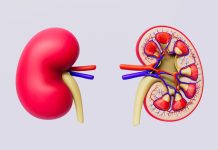
Diabetes occurs when there are not enough beta cells in the pancreas, or when those beta cells secrete too little insulin, the hormone required to keep blood sugar levels in the normal range.
Approximately 30 million people in the United States have diabetes and nearly 50 to 80 million more are living with prediabetes (also called “metabolic syndrome”).
Diabetes can lead to major medical complications: heart attack, stroke, kidney failure, blindness, and limb amputation.
In type 1 diabetes, the immune system mistakenly attacks and destroys beta cells.
A deficiency of functioning beta cells is also an important contributor to type 2 diabetes, the most common type of diabetes.
Thus, developing drugs that can increase the number of healthy beta cells is a major priority in diabetes research.
None of the diabetes drugs currently on the market can induce beta cell regeneration in people with diabetes.
In a recent study from the Icahn School of Medicine at Mount Sinai, researchers discovered a novel combination of two classes of drugs that could lead to the highest rate of proliferation ever observed in adult human beta cells—the cells in the pancreas that produce insulin—without harming most other cells in the body.
The finding involved one type of drug that is known to cause beta cells to proliferate and another that is already in widespread use in people with diabetes.
Together, they caused the cells to proliferate at a rate of 5% to 6% per day.
The result is an important step toward a diabetes treatment that restores the body’s ability to produce insulin.
The study is published in Science Translational Medicine. The lead author is Andrew Stewart, MD, Director of the Mount Sinai Diabetes, Obesity, and Metabolism Institute.
This current study focused on a family of proteins with various biological processes such as growth, development, tissue homeostasis, and immune system.
They could cause beta cells to proliferate at a rate of 5% to 8% per day. However, they would likely have side effects on other organs in the body that would prevent clinical use.
The next challenge for the team was developing ways to target regenerative drugs to the beta cells while avoiding other cells and organs in the body where they may elicit adverse effects.
In the study, the team combined DYRK1A inhibitors like harmine with a class of beta cell-targeting drugs, also known as GLP1R agonists, which are already in widespread use in people with type 2 diabetes.
They showed—in beta cells from normal people and people with type 2 diabetes, both in the tissue culture dishes and in human beta cells transplanted into mice—that combining harmine (or any other DYRK1A inhibitor) with any of the many GLP1R agonist drugs currently on the market for diabetes yields high rates of human beta cell replication, and does so in a way that is highly selective for the beta-cell.
The team says they may have found a way to convert a widely used class of diabetes drugs into a potent human beta cell regenerative treatment for all forms of diabetes.
The next goals of the project are to perform long-term studies in animals transplanted with human beta cells and to determine if any cells or organs in the body other than beta cells are affected by the new drug combination.
Copyright © 2020 Knowridge Science Report. All rights reserved.



